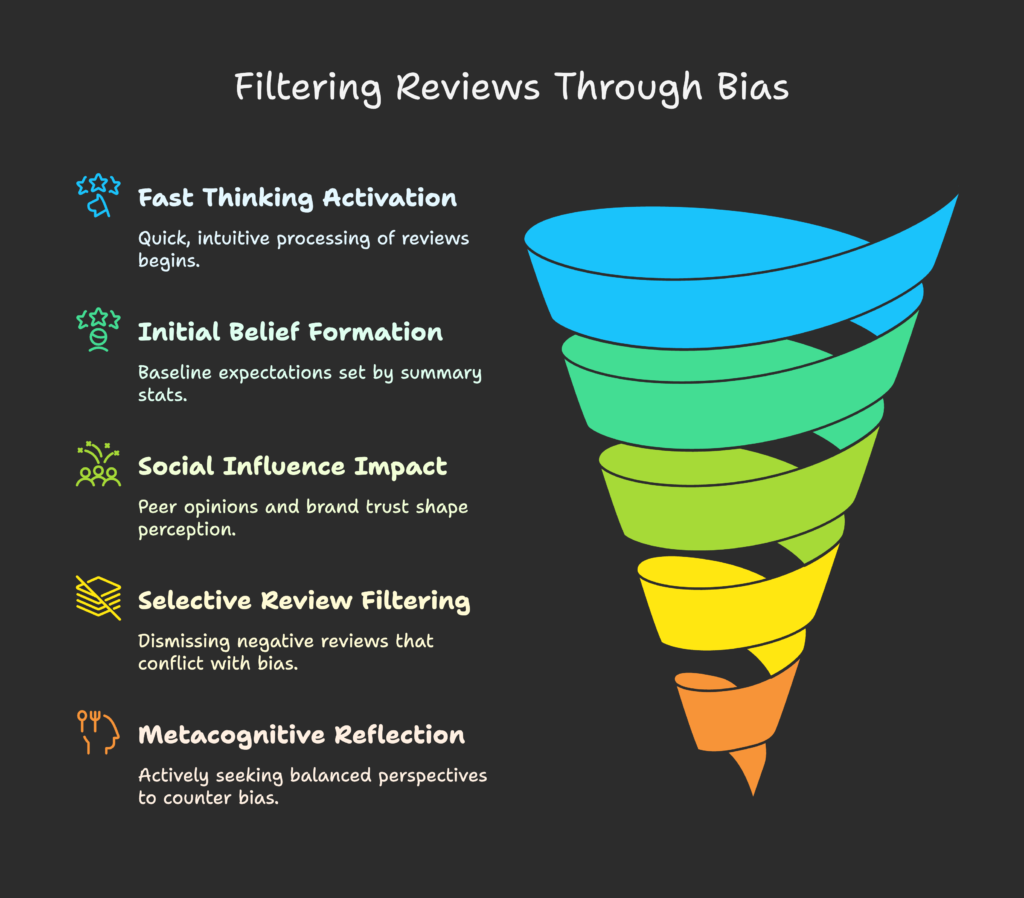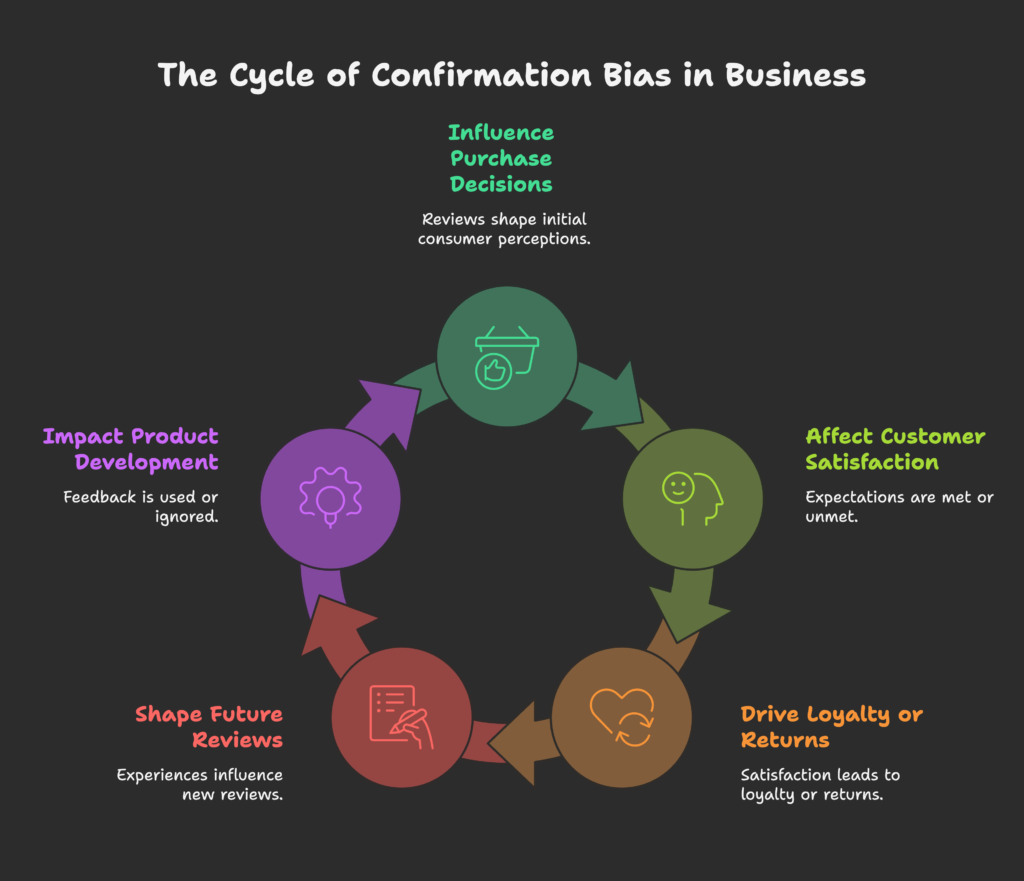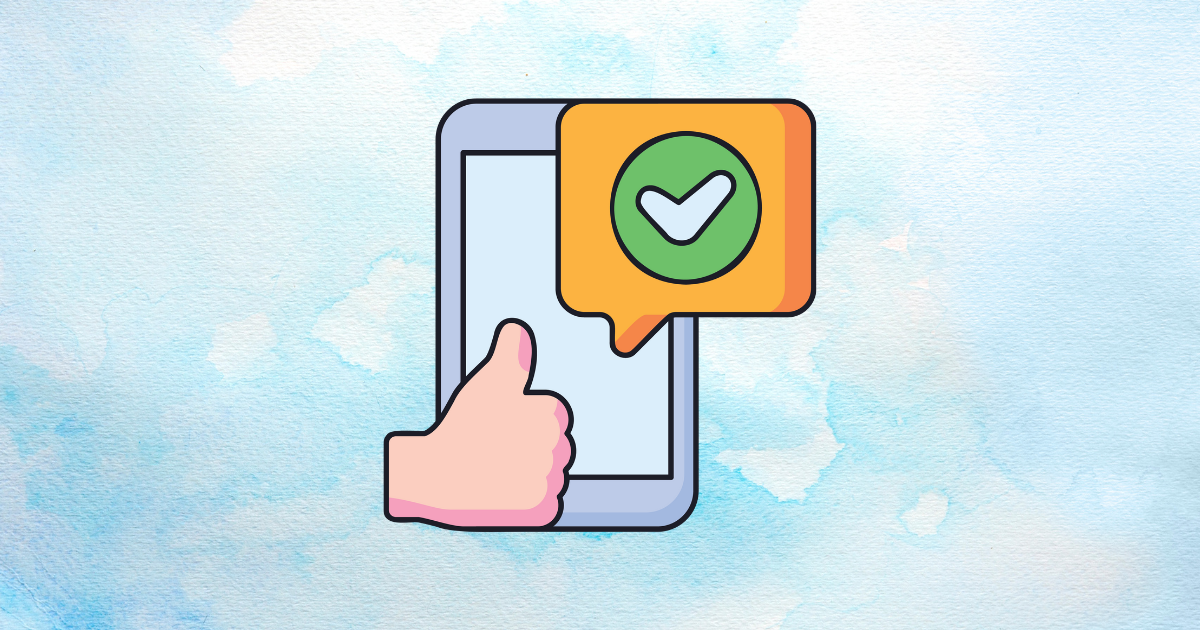Have you ever jumped to a conclusion about a product and then spotted more evidence to confirm your belief? That is the magic (or mischief) of confirmation bias. In this article, you will discover how confirmation bias shapes what people think of customer reviews and how it affects business decisions. By the end, you will have practical strategies for recognizing and managing this bias so you can create more balanced reviews and better serve your customers. Ready to dive in? Let’s begin!
Definition and Psychological Foundation
In simple terms, confirmation bias is the tendency to look for, interpret, and remember information that supports your existing beliefs. It’s like wearing special glasses that filter out anything that challenges your viewpoint. Historically, researchers in cognitive psychology have traced this bias back to how our brains process new information. Some suggest it offered an evolutionary advantage: quickly recognizing patterns helped our ancestors survive. However, in modern life, confirmation bias can lead us to ignore useful insights.
This bias isn’t just an occasional glitch—it shows up in our daily decisions, from choosing a restaurant based on one positive comment to favoring certain news sources because they match our perspective. By understanding how it works, you’ll be better prepared to spot it in your own thinking.
Now that you know what confirmation bias is, let’s explore why it’s such a big deal in e-commerce.
Relevance to E-commerce and Customer Reviews
Online reviews are powerful. A few lines of text can be the deciding factor between a sale and a missed opportunity. Data shows that positive reviews can significantly boost conversion rates, while negative reviews might scare potential buyers away. But here’s the catch: consumers often read reviews through the lens of their existing expectations. If they already believe a product is great, they’ll focus on glowing reviews and maybe dismiss the bad ones. This can distort the true value of the feedback.
As digital commerce continues to flourish, psychological biases in how we read and interpret reviews become increasingly important. Shoppers rely on reviews as a form of social proof, but if that proof is skewed by confirmation bias, both buyers and sellers can suffer.
Curious about our plan? Next, we’ll outline the goals of this article and show how you can use this knowledge to your advantage.
Article Scope and Objectives
In this article, you will:
- Learn how confirmation bias influences review reading, writing, and interpretation.
- Discover strategies to both leverage and mitigate its effects in a responsible way.
- Explore practical applications that can reshape your e-commerce approach.
We will look at the psychological background, real-world data, ethical considerations, and implementation plans for handling confirmation bias effectively. By the end, you will have a comprehensive roadmap for managing this bias in your review system.
Ready to see how psychology plays into reviews? Let’s jump to the next section!
The Psychology of Confirmation Bias in Review Contexts
In this section, we’ll dig deeper into how our brains process reviews. We’ll look at fast vs. slow thinking, how our initial opinions shape our views, and why being mindful of our own thought processes can help us break free from bias. You’ll see why something as simple as scanning star ratings or reading a single review can set the tone for your entire shopping experience.

Cognitive Mechanisms Underlying Confirmation Bias
Psychologist Daniel Kahneman famously described two modes of thinking: System 1 (fast, intuitive) and System 2 (slow, analytical). When you’re quickly scanning reviews, you’re often in System 1 mode—going with your gut feeling. Because of cognitive dissonance, if you already lean toward liking a product, you might skip or dismiss negative points that don’t fit your initial impression. This selective approach happens not just in reading but also in which reviews you remember later.
Now that you understand the mental “machinery” behind confirmation bias, let’s look at how first impressions shape everything else.
Formation of Initial Product Beliefs
Before you dive into detailed reviews, you probably notice summary information like average ratings or the number of reviews. These stats can set your baseline expectation. If you already trust a brand or it’s recommended by a friend, you are more likely to filter reviews with a positive lens. Social influence also plays a role—if everyone around you loves a product, you may be biased toward seeing only the good.
Additionally, the product category (for example, high-end electronics vs. budget kitchen items) and price point can color your perception. You might expect expensive products to have top-notch features, so you’ll emphasize positive reviews and downplay any negative feedback.
Wondering how this ties to your thinking habits? Let’s talk metacognition next.
Metacognition and Confirmation Bias
Metacognition is basically thinking about your thinking. If you realize you might be prone to ignoring conflicting viewpoints, you can actively seek balanced perspectives. Not everyone has the same level of metacognitive skill—some people automatically question their first impression, while others rarely do.
Strengthening your metacognitive abilities can make you less vulnerable to confirmation bias because you learn to spot your own blind spots. Imagine pausing after reading a positive review to actively look for a contrasting opinion—that’s metacognition in action.
Next, we’ll see how these internal processes show up in the real world of reviews.
Empirical Evidence: How Confirmation Bias Manifests in Reviews
Now it’s time to see what the research says. This section explores how confirmation bias affects the perception of positive vs. negative reviews, the ways people choose which reviews to read, and how they interpret or even create them. By understanding actual consumer behavior, you can better fine-tune your own e-commerce strategies.
The Positivity and Negativity Effects
Studies show that people are more likely to find positive reviews helpful if the product already has a high average rating. Conversely, if the average rating is low, negative reviews stand out more. This dynamic can lead to a sort of “echo chamber”—people who suspect a product is good will focus on good reviews, while skeptics will emphasize the negatives. Different product categories and platforms might show variations in these patterns, but the fundamental bias remains the same.
Next, we’ll see how shoppers selectively decide what to read in the first place.
Confirmation Bias in Review Selection
It’s common for consumers to sort and filter reviews by rating. Someone excited about a product might choose to view only five-star reviews, while a suspicious buyer might jump straight to the one-stars. Research indicates that the more certain you are of your buying decision, the more you’ll confirm it by reading reviews that match your initial opinion. This includes how much time you spend reading each review.
Now that we see how bias affects which reviews are chosen, let’s see how it influences the actual interpretation of review content.
Confirmation Bias in Review Interpretation
Sometimes, reviews can be ambiguous or mixed. A shopper under the spell of confirmation bias may latch onto phrases that support their outlook. If they’re already convinced the product is high quality, they’ll highlight any positive hints and dismiss complaints as minor. Technical details often get interpreted in a way that matches the shopper’s existing viewpoint. Additionally, if a reviewer seems credible, consumers are more likely to accept that reviewer’s opinion—especially if it aligns with their own beliefs.
How does this affect the reviews that end up getting posted? Let’s find out.
Confirmation Bias in Review Creation
Shoppers who adored a product or absolutely hated it are the most motivated to leave a review. Those with moderate opinions often remain silent. This creates a polarized review landscape. Also, people may engage in post-purchase rationalization, convincing themselves they made the right choice and leaving a review that confirms their own satisfaction.
Now that we’ve covered how confirmation bias affects the review ecosystem, let’s explore what this means for businesses.
Business Impact of Confirmation Bias in Reviews
In this section, we’ll examine how confirmation bias influences actual conversions, customer satisfaction, and even product development. You’ll see why businesses must pay attention to how potential buyers filter and interpret feedback, as it can shape everything from immediate sales to long-term brand reputation.

Effect on Conversion Rates and Purchase Decisions
Reviews are essential in guiding purchase decisions, but confirmation bias can magnify or reduce their impact. For example, if people are generally inclined to believe your product is excellent, positive reviews might convert browsers into buyers at higher rates. On the flip side, if some users start with a negative perception, it can be harder to change their minds, no matter how many glowing reviews you have. Over time, this can affect your sales and even the way your product is perceived across different price points.
After purchase decisions come loyalty. Let’s see how bias affects satisfaction and repeat business.
Impact on Customer Satisfaction and Loyalty
When a shopper’s initial positive expectation is confirmed by reading the “right” reviews, they tend to feel more satisfied. This feeds into brand loyalty. However, if they build high expectations and then feel misled, returns may increase, and loyalty can drop. This can trigger a cycle: returning customers read reviews in a certain way, become satisfied or dissatisfied, and then leave new reviews that influence future buyers.
Let’s move on to how product teams and marketers can be affected by these patterns.
Implications for Product Development and Marketing
If confirmation bias leads people to ignore real product flaws, businesses might miss important feedback. This is risky because genuine issues remain unseen, potentially hurting long-term success. Also, marketing campaigns might focus on reinforcing existing beliefs about the product rather than addressing actual consumer needs.
Brands sometimes find themselves in an echo chamber, hearing only what they want to hear from glowing reviews. It’s essential to actively seek out different perspectives to ensure a balanced view of where improvements are necessary.
Next, let’s see how we can use confirmation bias ethically to support business goals.
Leveraging Confirmation Bias Ethically in Business
This section will offer strategies for reinforcing positive perceptions without misleading customers. We’ll also see how to handle stereotypes, build trust, and carefully position reviews for maximum clarity and fairness. It’s about striking a balance between boosting sales and respecting your audience’s ability to make informed decisions.
Reinforcing Positive Brand Perceptions
If your product genuinely delivers great value, it makes sense to showcase reviews that highlight your strengths. Align these reviews with your brand’s core message, so customers see consistency. Make sure, however, that you include honest and balanced representation. Consumers are quick to spot inauthentic strategies, and credibility is worth protecting.
Now let’s see how existing stereotypes about product categories might also be used carefully and ethically.
Using Stereotypes and Category Expectations Strategically
Different categories have built-in expectations. For instance, buyers might expect eco-friendly products to be slightly more expensive but worth it for sustainability. Ethically leveraging these beliefs means addressing them openly. Don’t over-promise; instead, be transparent about how your product meets or exceeds the usual category standards. This way, you play into existing beliefs without deceiving or misleading consumers.
Next, we’ll dive into the importance of trust and security in your messaging.
Building Trust Through Confirmation of Safety and Security
Shoppers look for cues that tell them “this is a safe place to buy.” These can include trust badges, secure checkout symbols, or verified buyer labels. Highlighting reviews that mention reliable shipping or data protection can confirm people’s desire to shop in a safe environment. But again, be sure to balance this with transparent communication about any risks or terms, so buyers don’t feel blindsided.
Finally, we’ll explore how to place reviews in ways that respect the user’s journey while also guiding them effectively.
Strategic Positioning of Reviews
Where and how you display reviews can heavily influence which ones customers notice first. Consider:
- Prominent placement: Put balanced, helpful reviews in spots with maximum visibility.
- Sorting and filtering: Give shoppers easy tools to find relevant feedback without trapping them in a bubble of only positive or negative opinions.
The goal is to ensure authenticity rather than hiding unfavorable perspectives. Ethical practices maintain a trust-based relationship between your brand and your consumers.
Now let’s focus on what you can do to reduce negative effects of confirmation bias.
Mitigating Negative Effects of Confirmation Bias
This section is your toolkit for combating bias in customer reviews. We will discuss how to design review systems that encourage varied perspectives, educate your customers, build metacognitive awareness, and maintain transparency. Each strategy helps ensure reviews remain a fair tool for evaluating products and services.
Review System Design Strategies
A well-designed review system can encourage a range of opinions. Consider:
- Diverse review prompts: Ask questions that lead to balanced feedback, not just “Was the product great?”
- Balanced display: Show a mix of positive, neutral, and negative reviews up front.
- AI-driven insights: Some systems use AI to highlight reviews that differ from the norm, offering fresh perspectives.
After designing a fair review system, we should also help consumers become wiser readers. Let’s see how.
Consumer Education Approaches
People often don’t realize they’re biased when reading reviews. So:
- Include brief tips reminding shoppers to look at a variety of reviews.
- Offer prompts that encourage critical thinking, like “Check both low and high ratings!”
- Provide easy-to-read guides that explain common cognitive biases.
Beyond simple education, we can help customers and ourselves become more aware of the mental process itself.
Building Metacognitive Awareness
Encourage a pause before finalizing decisions. Small nudges in your interface—like a reminder asking “Have you seen a different point of view?”—can inspire reflection. Tools that highlight conflicting information can also help. Over time, guiding shoppers to think about how they think will make them better evaluators and more confident buyers.
Speaking of transparency, let’s check out how open communication about review collection can build trust.
Transparency in Review Collection and Display
Explain how you gather reviews: Are they all from verified purchases? How do you handle any suspicious or spammy ones? Also, be clear about any algorithms that sort or highlight reviews. When consumers feel a system is transparent and honest, they’re more likely to trust the feedback and possibly overcome their own biases.
Up next, let’s see how to put all these ideas into practice.
Practical Implementation for Businesses
Ready for a roadmap you can follow? This part gives you concrete steps and frameworks to audit your current system, adopt new technologies, unify your team around the importance of bias management, and measure your success.
Audit and Assessment Frameworks
The first step is to understand how much confirmation bias may already be affecting your business:
- Customer journey mapping: Identify where in the journey reviews have the biggest impact.
- Data analysis: Look at correlations between review types and conversion or returns.
- Vulnerability check: Spot which products or categories are most at risk of biased reviews.
Once you know where you stand, it’s easier to explore the tools that can help.
Technology Solutions and Platforms
Look for review management systems that offer:
- Advanced AI features that highlight diverse viewpoints.
- A/B testing to experiment with different review display formats.
- In-depth analytics to measure how biased review usage affects sales.
But technology alone isn’t enough—your entire organization needs to be on board.
Cross-Functional Strategies for Organizations
Teams across marketing, product development, and customer service should work together to keep review systems balanced. Training programs can help employees recognize how confirmation bias might skew their own work. It’s also wise to set ethical guidelines around how reviews are collected and displayed.
After aligning your teams, it’s time to plan your actual rollout.
Implementation Roadmap
For the short term, you might start by adjusting how you display reviews—showing both positive and negative upfront. Over the long run, you could integrate AI tools, refine the review submission process, and continue training your staff. Make sure to set clear metrics for evaluating success, like reduced returns or increased customer satisfaction.
Curious how these ideas play out in real life? Let’s look at some examples.
Case Studies and Real-World Examples
Here, we’ll explore both successes and failures in managing confirmation bias. By seeing what works (and what doesn’t), you can adapt these lessons to your own business. We’ll also check out cutting-edge approaches that show promise for the future.
Successful Bias Management Approaches
Certain companies have tackled confirmation bias head-on by:
- Featuring contrasting reviews on the main product page.
- Encouraging customers who leave a review to highlight both pros and cons.
- Holding open Q&A sessions to address consumer questions in real time.
The results often include higher trust levels and better sales conversions. Sometimes, highlighting a few critical comments alongside positive ones makes the product appear more authentic overall.
But not everyone succeeds. Let’s see why.
Cautionary Tales and Failures
Some brands have faced backlash for manipulating or filtering out negative reviews. This can lead to lost consumer trust and even legal issues. In extreme cases, it has triggered regulatory fines and long-term damage to brand reputation. Deceptive practices eventually come to light, creating a cautionary tale for anyone tempted to ignore or hide honest feedback.
Now, let’s end with the best emerging practices for tackling confirmation bias.
Emerging Best Practices
Companies are experimenting with:
- Interactive review platforms that prompt deeper engagement.
- Machine learning tools to spot biased patterns in real time.
- Continuous user feedback loops to refine the review system.
These forward-thinking methods could redefine how we handle customer feedback, making reviews more transparent and trustworthy.
Next, we’ll peek into the future and consider what might happen as technology and consumer awareness evolve.
Future Trends and Considerations
In this section, we will look at how technology, consumer behavior, and regulations are shaping the future of reviews. Staying ahead of these trends can help your business maintain credibility and adapt quickly to new challenges in online feedback systems.
Technological Developments
Artificial intelligence is becoming increasingly adept at spotting patterns, including bias. Future systems might personalize review feeds based on an individual’s browsing history while also nudging them toward more balanced perspectives. Voice and immersive tech (like AR and VR) will add new layers of complexity to how reviews are created and consumed.
Consumers are also becoming more aware of manipulative tactics. Let’s see how that might impact things.
Evolving Consumer Awareness
As shoppers gain digital literacy, they become more suspicious of exaggerated claims and filtered feedback. Younger generations, in particular, often look for authenticity and transparency. Some consumers even seek out negative reviews first, hoping to spot consistent product weaknesses.
Beyond consumer awareness, regulations and ethics will also shape the landscape.
Regulatory and Ethical Horizons
Authorities are introducing guidelines to ensure online reviews are fair and authentic. Some require that review sites disclose their moderation methods. Industry groups also encourage self-regulation to avoid the need for stricter laws. As these rules evolve, businesses that maintain ethical practices will be in a better position to adapt and thrive.
Finally, let’s wrap up our journey with a summary and some closing thoughts.
Conclusion: Balanced Approach to Confirmation Bias
By now, you’ve explored how confirmation bias can shape every step of the customer review process, from how people read, interpret, and write reviews to how businesses can manage these biases ethically.
Key Takeaways for Businesses
- Understand the bias: Recognize that confirmation bias influences both customers and your own team.
- Ethical leverage: Highlight genuine positive feedback, but avoid hiding negatives.
- Balance is crucial: A healthy review ecosystem includes diverse viewpoints.
- Long-term focus: Trust and credibility are more important than short-term sales boosts.
With these insights in mind, let’s see how you can roll out effective strategies.
Implementation Framework
Start by auditing where bias hits you hardest—whether it’s in customer service or marketing. Then, prioritize fixes that offer the biggest payoff, like adjusting review displays or training your team. Continue to measure success and refine your approach. Confirmation bias isn’t something you fix once; it’s an ongoing challenge that needs regular attention.
You’re nearly at the end! Let’s glimpse the future of reviews and your role in shaping it.
Final Perspectives on the Future of Reviews
As technology evolves, so do consumer behaviors. Staying informed about emerging tools and best practices helps you maintain a reliable review environment. Businesses play a key role in creating transparent, consumer-empowering feedback systems that balance commercial objectives with ethical considerations.
Remember, a truly healthy review ecosystem benefits everyone: it builds confidence in shoppers, fosters loyalty, and drives sustainable growth for your brand.
References
- Sen, S., Mitra, S., & Zhang, H. (2016). Research Note—When Do Consumers Value Positive vs. Negative Reviews? An Empirical Investigation of Confirmation Bias in Online Word of Mouth. Information Systems Research, 27(1), 131-144.
- LinkedIn. (2023). How does confirmation bias impact your customer satisfaction and loyalty?
- Venture Harbour. (2023). 7 Ways Confirmation Bias Can Boost Your Conversions.
- Rollwage, M., Dolan, R.J. & Fleming, S.M. (2021). Confirmation bias is adaptive when coupled with efficient metacognition. Philosophical Transactions of the Royal Society B, 376(1822).
- Munn, Z., & Jordan, Z. (2016). Assessing Risk of Bias in Systematic Reviews. PubMed.
- Sen, S., Mitra, S., & Zhang, H. (2015). When Do Consumers Value Positive vs. Negative Reviews? SSRN.
- Wang, S. S., Aribarg, A., & Van der lans, R. (2021). Confirmation Bias in Quality Learning from Product Reviews.
- Forbes. (2023). Overcoming Confirmation Bias.
- Simplesat. (2025). Cognitive bias in handling customer feedback: How to be more objective.
- Rollwage, M., Dolan, R. J., & Fleming, S. M. (2021). Confirmation bias is adaptive when coupled with efficient metacognition. PMC.
- PMC. (2017). Bias in Systematic Reviews—Let the Reader Beware.
- Harvard Business School Online. (2016). Confirmation Bias: How It Affects Your Organization and How to Overcome It.
- Rollwage, M., Dolan, R. J., & Fleming, S. M. (2021). Confirmation bias is adaptive when coupled with efficient metacognition. Royal Society Publishing.
- Cochrane Training. (2017). Chapter 1: Starting a review.
- Cialdini, R. B. (2007). Influence: The Psychology of Persuasion. HarperCollins.
- Kahneman, D. (2011). Thinking, Fast and Slow. Farrar, Straus and Giroux.
One Last Note for Shopify Store Owners: If you’re looking for a practical way to enhance your sales process, consider using the Growth Suite app. It helps you manage your online store more effectively, giving you extra time to focus on strategies like balancing out confirmation bias in your reviews. Here’s to happy customers and sustainable growth!




